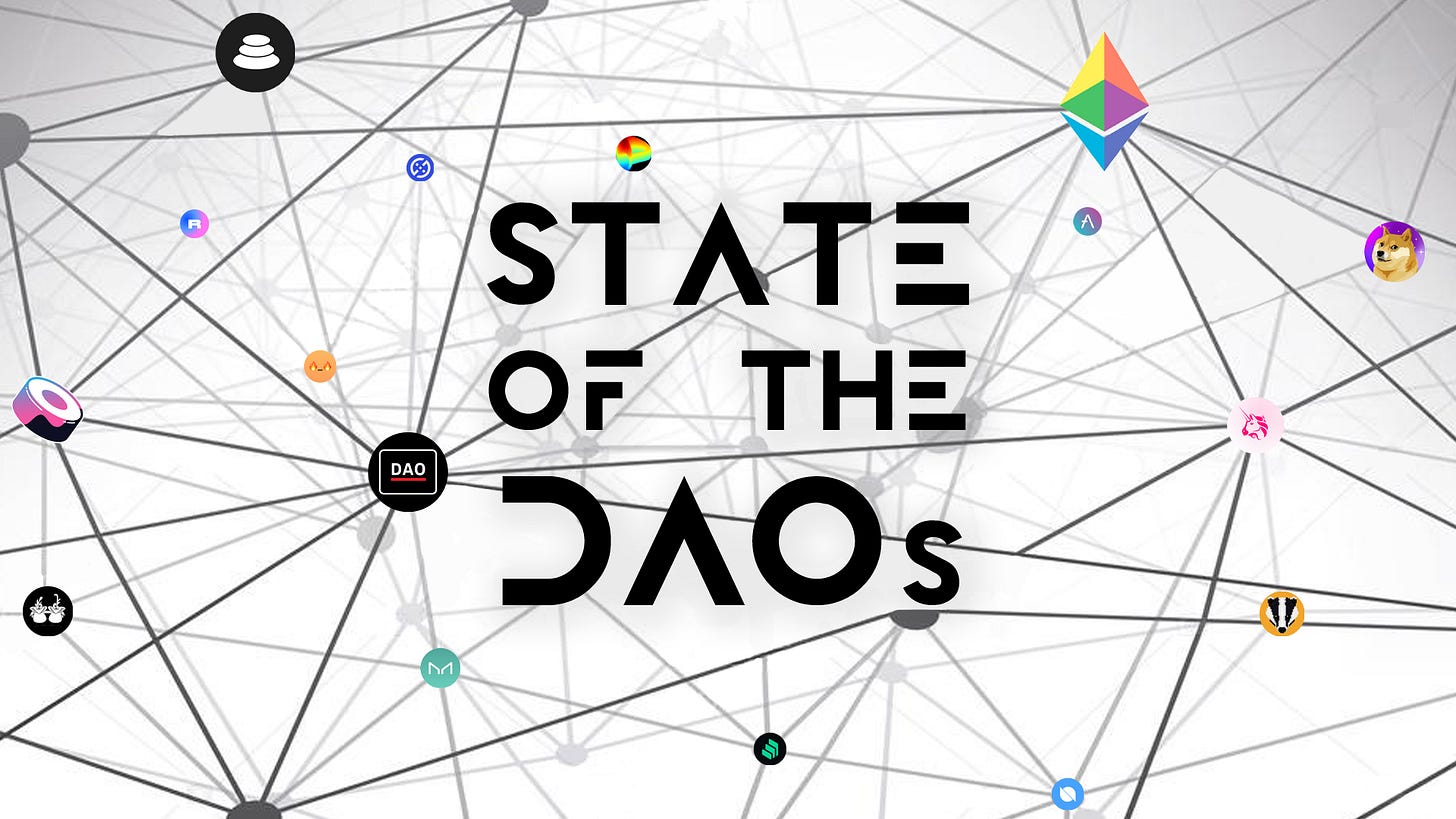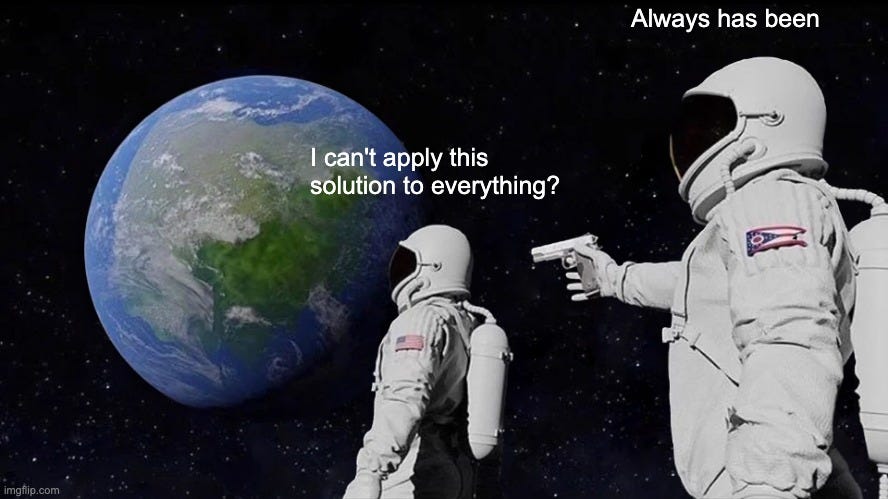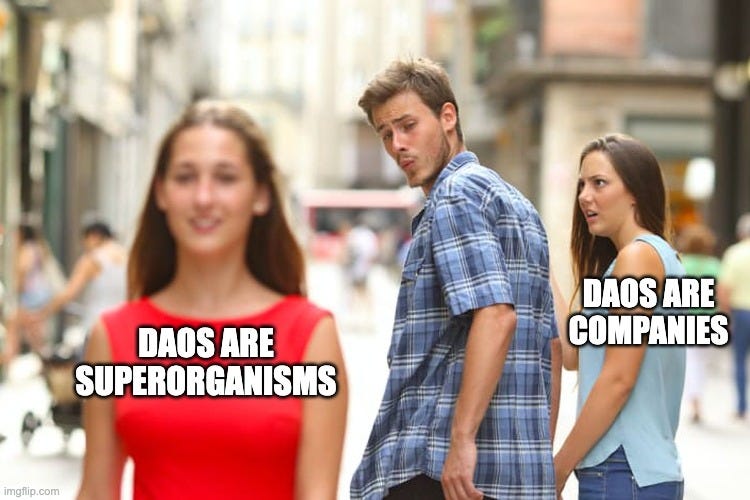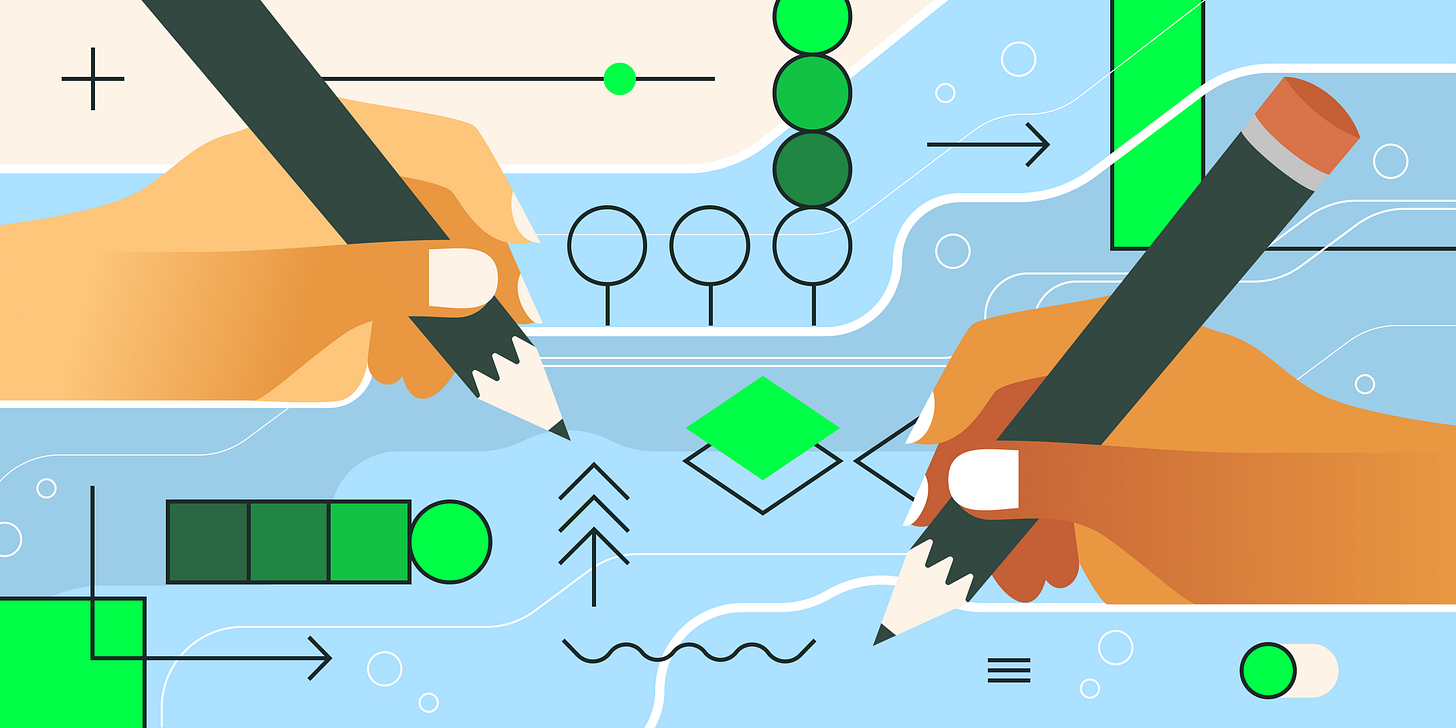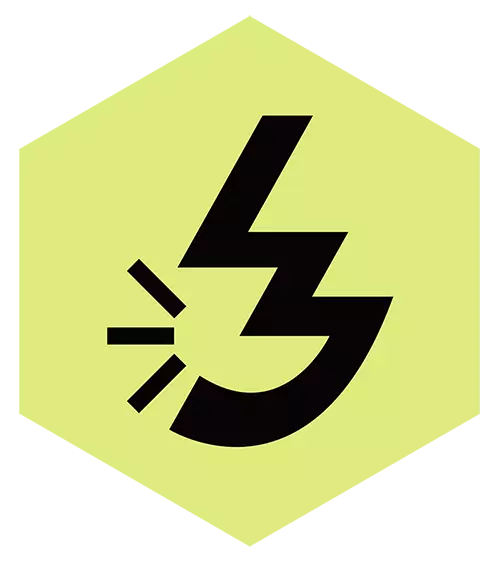Harnessing the Hive Mind | State of the DAOs
You're reading State of the DAOs, the high-signal low-noise newsletter for understanding DAOs.
Gm and welcome to DAOlife! DAOs are an experiment in organizational structure and coordination. While many different models have been tried out in the DAO ecosystem, sometimes we need to look to nature for guidance on what works best. This week, Jake and Stake pokes around the bee hive and brings back lessons DAOs can use to inform their communication, deliberation, and problem solving processes.
After that, we share the TL;DR on the latest DAO ecosystem takes and thought pieces, making it easy for you to cut through the noise and stay up to date on the world of DAOs.
This is the current state of the DAOs.
Contributors: BanklessDAO Writers Guild (Jake and Stake, hirokennelly.eth, teeLEROO, Thalia_M, theconfusedcoin, AustinFoss, siddhearta)
This is the official newsletter of BanklessDAO. To unsubscribe, edit your settings.
🙏 Thanks to our Sponsor:
DAOs are Superorganisms
Harnessing nature to improve decision-making processes
Author: Jake and Stake

DAOs are the newest organizational trend, allowing humans to interact with each other and create centers of exchange and cooperation in ways that would not have been possible before blockchains and the internet. These digital organizations use tokens as a point of coordination, giving everyone a direct say in the direction of the organization while incentivizing contribution.
Many DAOs experience coordination failures. Humans are not culturally wired for such a flat structure because, for most of human history, we operated more like packs of wolves or tribes with hierarchies. The flatness of DAOs are a new and novel way to organize, and while it’s taking some time for humans to get used to, some organisms have organized with flat structures for tens of millions of years.
Typically, these organisms have a “hive mind.” In other words, they operate as if they were a single intelligence, creating a superorganism: a group of organisms of the same species that work together synergistically. Some well known examples include bees, ants, and other insects. We can look at the way colonies of insects organize as a model for how to structure DAOs.
DAOs can utilize models from the natural world to figure out how to make decisions, generate ideas, and move in a singular, goal-oriented way. Let’s learn from the original “hive mind”: the honey bee.
The Waggle Dance
For years, it was a mystery as to how social bees were able to coordinate their complex actions. For example, it was assumed that each bee made concentric circles around the hive to find food sources, but in 1944, Karl Von Frisch found an explanation.
He observed that bees in the hive were going directly to sites that they had never been to before. This indicated that worker bees could give directions to other bees about potential food sources.
Von Frisch found that bees will communicate through dance. Called a "Waggle Dance," bees perform it by shaking their abdomens while walking in a straight line. Bees can use this dance to communicate the direction, distance, and quality of a known food source.
Distance - The length of time that bees waggle during their dance communicates distance. One second is approximately 1 kilometer.
Direction - Bees will dance in relation to a vertical line to communicate direction. In this dance, the vertical line represents the direction of the sun and bees will waggle at an angle to the vertical line. The direction of the waggle dance corresponds to the angle of the pertinent location (whether it's a patch of flowers, a water source, or a new nesting site). For example, if a bee waggles in a direction 45 degrees off of the vertical line, the place of interest is 45 degrees off from the direction of the sun.
Quality - The quality of food sources can also be determined via dance. If they dance "vigorously," it's presumed that the site is very good.
While bees are constantly moving around in the hive and shaking their bodies, communication often happens on a designated “dance floor” close to the entrance of the hive.
DAOs also have a place where formal discussions are held: proposal forums. When DAO members think of a new idea, project, or proposal, they usually don’t go directly to the DAO treasury to get funding. There’s a series of soft consensus checks to make sure it’s aligned with the DAO and worth pursuing. The dance floor is just a bee hive’s forum for making decisions and gathering consensus.
Note that bees communicate with incredible accuracy, conveying direction, distance, and quality. Everything needed to recreate their flight path outside the nest.
Humans have something more expressive: language. This communication is done through documents and Discord messages, not dance and scent, but both humans and bees must enter each other's minds and figure out what the other is thinking.
The lesson for DAO members is to be as accurate as possible with your posts. The more others can understand your idea, the better their understanding of your proposal—the pros and the cons. Vague ideas and convoluted posts will only lead people down a path you did not intend and cause confusion when you want effectiveness.
Direct Bee-mocracy
Bees can use these sophisticated communication tools to locate food sources, water sources, and new nesting sites. For instance, when a bee hive gets too large for its nest, the hive will create a new queen and split into two populations. One third of the population will stay with the new queen in the current nest, while the other two-thirds and the original queen look for a new location for their hive.
There are many factors to consider. Among other qualities, a potential new home must be large enough to support storing honey to last the winter, it must be high enough to protect the hive from predators, and it must be water-proof to prevent leaks during rain storms.
But how do they decide where to go?
When splitting into a daughter colony, bees will hold democratic debates to evaluate potential nest sites, advertise their discoveries to others, openly deliberate, settle on a final site, and navigate together to their new home.
But first, all information is put on the table in an “information gathering” phase. The search begins with a few worker bees taking on new roles:
“In a nutshell, nest-site scouts are elderly bees who were working as common foragers but then quit this line of work when they sensed that their colony, preparing to swarm, no longer needed additional food.” - Honeybee Democracy (Thomas D. Seeley 2010)
Next, debates progress as bees explore each option. If a bee finds a site they like, they will do a waggle dance to signal the site’s location. If another bee likes the site, they will also waggle in the same direction. Scout Bees will continue to search for locations and communicate them as potential nesting sites. Eventually, the bees will vote for locations through their dance and whittle down the choices until there is only one left.
In the famous Eck Bee Debate (Lindauer, June 1951), multiple options are brought to the table and deliberated upon:
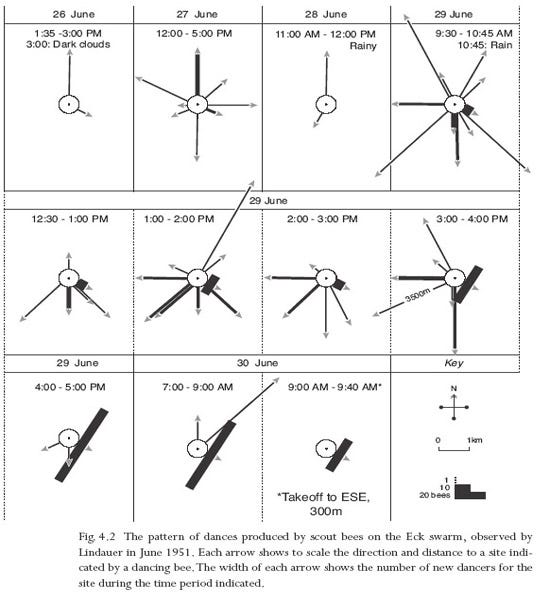
This process is not unlike DAO votes in Discord, proposal votes, and, finally, snapshot votes. Bees and humans make decisions through debates, deliberation, and even reconsideration when a potential solution is shown to be insufficient. We already do this in public, but can we do better?
ABCs, DAOs, and Collective Intelligence
In computer science, the Artificial Bee Colony (ABC) Algorithm (Derviş Karaboğa 2005) is an optimization algorithm to find a global maximum. The algorithm is inspired by the foraging behavior of honeybees when looking for the best option among several.
The algorithm consists of three parts: employed foraging bees, unemployed foraging bees, and food sources. Foraging bees look for and evaluate food sources in order to find the best option. The algorithm looks like this:
This algorithm has been used to solve a variety of problems in different fields:
Electrical engineers use it to determine the optimal position of solar panels when they are in partial shade.
Aerospace engineers use it to determine the optimal trajectory for the reentry of hypersonic vehicles.
Computer scientists have used it to plan the path of robots, for neural network training, cluster analysis, protein structure prediction, and stock market forecasting.
Could DAOs harness this algorithm to improve their own decision making processes?
Imagine a hard decision must be made in an ambiguous environment. DAOs can select a few highly informed members (“elder bees”) to create a framework for the problem, put the problem to the community, and collect community solutions (including their own). These would be considered the “employed bees” in the first part of the algorithm.
After a submission period, we allow other members to explore and vote for solutions they deem most effective—in an onlooker phase—and each member can iterate upon their chosen solutions in order to create one that is more effective. Afterwards, the DAO can hold a review period of the new and old solutions to determine which one is best.
Once the exploration of a solution has been exhausted and determined to be suboptimal (found to be clearly worse than others), it can be replaced with a better solution or a new “random” solution to explore. This is the scout phase, where poor solutions are pruned, promising solutions are kept, and new ideas are brought to the table.
Finally, in the “memoize phase” solutions are evaluated and ranked, before the next evaluation period occurs. DAOs can continue to iterate on promising solutions or dedicate more resources to new ideas in the next iteration.
DAOs can create several evaluation periods, based on the number of iterations (cycles) they want to use.
In this case, novel solutions should be encouraged because diversity of thought is a DAO’s advantage. As an example, honeybees will allocate a greater number of workers to particularly rich sources of nectar, yet other bees will continue to maintain contact with poorer flower patches. This is because a good patch today may not be a good one tomorrow. By maintaining memories of patches that may eventually become rich with food, the bee hive’s flexibility increases.
Actions that may seem like errors are actually insurance policies.
"By virtue of having numerous individuals examining a problem and presenting possible solutions to it, both a bee swarm and a town meeting are much more capable than any solitary bee or single person in coming up with a broad range of alternative options. And the broader this range of options, the more likely it will include the one best option." - Honeybee Democracy (Thomas D. Seely)
I think one of the highest value activities DAO contributors can do is propose competing solutions. It’s easy to snipe and take down other people’s ideas without offering a viable solution. It’s also a waste of time unless the commenter puts forth something useful. Usually, proposals are created, commented on, and the feedback is integrated, but this is only helpful if the feedback is constructive.
Let’s try creating a marketplace of ideas where members can vote for proposals as they are presented without taking half-measures. This creates feedback that is only constructive because it’s either building on something presented earlier or proposing a new solution, entirely.
The Value of Focus
Having a stable of possible solutions is a useful technique to ensure success, but sometimes it’s better to decide and commit. As a rule of thumb, focus is important at the high level.
The clearest use case is in creating the mission. A DAO that is confused about what its mission is will be pulled in a thousand directions. There should be some singular, guiding purpose to set the stage for DAO-wide coordination. This mission (and principles when achieving it) should be pointed at, repeated, and returned to again and again.
In this way, global consensus is more important than continuing to explore suboptimal solutions. If a hive is split between two nest-sites, the bees do not split up and go to both. They get consensus and move as one.
“By contrast, in some situations social insects need to make a dissent-free collective decision. For example, when a honeybee swarm is faced with a choice among several suitable nest-sites, it seems of paramount importance that the swarm as a whole selects only one.” - Deciding on a new home: how do honeybees agree?
In DAO-land, the presence of two competing missions creates a loss of focus, increases confusion, and hurts the DAO’s ability to control its own narrative. In this case, it’s better to pick one solution and commit to it. Some contributors may drop off, but the power of a singular mission cannot be understated.
Closing Thoughts
When making hard decisions we're likely to go to others and ask for their advice. We could ask our friends, colleagues, or simply search Google or Quora. If “two heads are better than one”, maybe a collection of heads is better than two. This is collective intelligence in action.
Tokens have created an incentive mechanism that coordinates groups of people in ways that have not been possible before. DAOs can utilize collective intelligence by creating a marketplace of ideas where they compete with each other for members’ votes.
"One valuable lesson that we can learn from the bees is that holding an open and fair competition of ideas is a smart solution to the problem of making a decision based on a pool of information dispersed across a group of individuals." - Honeybee Democracy (Thomas D. Seely)
In general, using biology as a framework to solve problems is very useful. Nature is parsimonious, and leaves no room for error. We may find solutions to our problems by taking note of the world around us.
DAOs should aspire to:
Mind merge with each other by expressing ideas clearly and avoiding vague language
Create a marketplace of ideas and hold open debates about possible solutions
Explore multiple options at once to avoid over-indexing on a bad solution
Decide and commit to a mission and values as a collective
If we can do this, perhaps the future of DAOs is not as companies, or even as cities, but as superorganisms where, instead of a collection of bees, each member is a highly intelligent organism with a prefrontal cortex.
Actions steps
📖 Read DAOs are the Opportunity of a Lifetime | Samanthaj
⛏️ Dig into The bulldozer vs vetocracy political axis | Vitalik
🎧 Listen Bankless Show 103 - Blockchains are Cities | Haseeb Qureshi
🙏 Sponsor: Parcel - Simplifying payouts for DAOs.
DAOs at a Glance
Hand-picked articles to understand the current state of the DAO ecosystem
How to DAO Ownership 101: What Does It Mean to Be an Owner?
Author: Roxine Kee
Finding, developing, and empowering owners within a DAO is the key to sustainable decentralization. —Roxine Kee
DAOs are community-owned organizations, which means there are no CEO’s in charge of all the decision making. But if that’s the case, why are members with ownership mentality so hard to find? In this article, Roxine lays out four standards for how members can start to act like owners:
Take accountability & responsibility for outcomes, not just inputs: Don’t just submit your work, own
Be Self-directed: Don’t wait to be picked or told what to do. Find out what needs to be done and do it. Create the roadmap rather than waiting for directions on what to do next.
Initiate & share the mental load: Initiate meetings, coordinate with other members, take the reins and lead when needed. But also know you don’t have to go alone and sharing the weight makes for easy traveling.
Be a professional, respect your work & take your contribution seriously: DAOlife might seem like a hobby or a side hustle, but this is your opportunity to care about what you do and how you do it. It’s time to go pro.
Identity as Information
Author: Danny@EthDenver
In this article, Danny explores the nebulous term identity, thinking of it as a tool to store, manage, and retrieve information.
In Web2, information for identity is fragmented and an application must compile it. This means that many systems are operating at once, and user data is controlled by the application. The system fails in making more information more legible more consistently.
The Web3 innovation is the blockchain, a distributed ledger technology (DLT) that allows for a shared database. It removes the need for each application to apply its own identity system, and gives users greater control over their own data.
For efficiency, it would be ideal if a single blockchain held the registry, but this structure is too rigid. The solution is a distributed user table. It sees users bringing their data to the application, and it avoids the siloed systems of Web2.
Additionally, it checks the boxes for the Web3 vision:
Pseudonymous-first: there is no account creation, the user simply brings a cryptographic keypair.
Generative: information accumulates to build the holistic identity.
Composable: information can be ported across contexts.
Separable and Selective: information sets can be encrypted or split up.
How DAOs are changing the Venture Capital world
Author: VoiceDAO
DAOs are having a “break out year” and one of the sectors where they are currently showing a lot of promise is in the world of venture capital. Venture capital is private equity funding provided by investors to companies. Access to the VC World has always been limited to the ultra-rich, but with DAOs its being brought to everyone and anyone. This has given rise to a concept called Decentralized Venture Capital (DVC).
DVC is a new venture fundraising and investing model that allows non-accredited investors to invest in promising startups around the globe. Since all funds are maintained in cryptocurrencies, one of the biggest advantages of DVCs is the speed at which it can transfer funds to eligible startups. Also, participation of a large community in deciding who gets funding is advantageous as you get opinions from people with varied skill-sets.
Working Groups are the Scaffolding: A Foundational Approach to Sustainably Scaling DAOs
Author: Yuan Han Li and BraveNewDeFi
As the popularity of DAOs continues to grow and they are forced to scale, members must decide the best organizational growth framework. One efficient and effective scaling method is to organize contributors into small working groups made up of token holders. Community-driven working groups engage contributors and uncover unknown talent, while aligning incentives for both contributors and the community. But how do working groups do this?
Working groups scale governance when delegated discretionary executive powers — not everything needs to be put to a vote.
Advisory working groups work to educate the community to reduce the time needed to achieve consensus.
Working groups allow for the formation of specialized teams to tackle specific issues.
Working groups should only have the authority required of their mandate. A founding charter is necessary to outline the scope of the working group, such as its purpose and objective, whether it’s temporary, the needed authority, the skills required, and the group’s decision-making processes.
The founding charter of a working group allows the DAO to make sure its incentives are aligned with the working group. Community-based checks and balances on the working group are necessary to ensure continued alignment, and it’s good practice to limit the duration of working groups to under six months and give the community powers to restrict or dissolve the working group at a later time.
Working groups should have formal and informal reporting requirements. Formal reports are things like performance reviews, meeting notes and expense analyses, while informal reports are just open discussions. The ethos of a working group should be one of transparency.
Working groups need a clear budget and should be funded in line with their objectives and projected deliverables. When considering working group funding, the treasury should be careful not to underfund a working group, as good compensation may help attract quality contributors. DAOs should create a culture that rewards talent and performance.
Working groups allow for more efficient governance, education opportunities, and specialization within a DAO. With the proper checks and balances, community-powered working groups will enable DAOs to scale while providing funding to key contributors.
Musings on Governance
Author: Larry Sukernik
Governance within DAOs is still very much a work in progress. Being such a new primitive for individuals to use as an organizational tool, we’re still throwing paint at the wall to see what sticks. The author of this article has shared their musings on what is and is not working so far.
Some of the lessons they’ve observed within DAOs are actually very prevalent problems in traditional organizational structures. Corporate phenomena like design-by-committee and bikeshedding end up being swept under the rug until they become a real problem. This could perhaps indicate that these are problems inherited from human nature rather than problems caused by the previous organizational structures.
Still some lessons come from problems that emerged directly from DAOs themselves, such as the problem of openness versus quality. This is a fantastic collection of some key dos and don’ts for all to consider as DAO governance continues to emerge.
Ecosystem Takes
🔥 and 🧊 insights from across the DAO ecosystem
DAOs and the Future of Decentralized Branding
Author: CabinDAO
🔑 Insights: As CabinDAO continues to grow and develop more products, they are turning their attention to what decentralized branding looks like in DAOs. Here are their key takeaways:
The Current State of DAO Branding: There are so many DAOs and new ones are popping up every day. It is difficult to define a DAO by its brand or style, but this is also a big opportunity.
Background on Traditional Branding: Branding is the cornerstone of marketing and advertising. Traditionally, a brand is a reflection of things like the organization mission, vision, and values, while incorporating style and design elements.
A Framework for Decentralized Branding: Some key components exploring a new approach to branding:
Branding being like a school of fish that moves in unison without clear instructions
Branding as a reflection of the collective community
Brand leaders set the foundation for style elements and product experience
Brand followers use existing assets for faster and consistent production
Branding continues to sense and adapt as the DAO evolves
Decentralized Brand Building at Cabin: CabinDAO started with a centralize approach to their mission, values and brand assets, and is now letting the DAO riff and explore how the brand will be expressed. Check out their brand assets and expression matrix!
A product manager’s guide to web3
Author: Jason Shah
🔑 Insights: Product management in Web 3 is different from its Web2 version because it is more art than science, more versatile and more public. Unlike in Web2 where the founder or early product manager can be crucial in deciding what and how to build, in Web3 the product experience doesn’t matter as much to the success of the project relative to the token incentives (Staking and AMMs), trading pairs, artwork (NFTs), network design, transaction speed, security, or other attributes. In Web3 Product managers need a different set of skills:
Web3 startups generally hire a PM when the engineers have become inefficient, product experience is complex or critical to traction, and when there is a mix of externally facing activities that a versatile PM can do.
Web3 PMs are responsible for the success of communities rather than increasing acquisition, engagement, or revenue.
Web3 PMs have to think about protocol design, tokenomics, user safety, security, growth marketing, community engagement, and much more.
As a Web3 Product Manager you have to:
Prioritize execution over vision/strategy
Do user research, business development, and marketing directly
Focus on perfecting the details rather than expanding features
Understand your users without their email addresses, tracking tools, or running A/B tests
Design your product around the trade-offs of a given L1/L2 blockchain, like Ethereum or Solana
Be extremely careful about what you deploy in smart contracts, and that slows development time
Remember that you cannot rely on proprietary code, trade secrets, and data moats as your competitive advantage
Understand that you cannot make all product decisions unilaterally and may not control your roadmap
Prioritize user security, because with every transaction there are funds at stake
Realize that regulatory concerns have mostly shifted from Web2 to Web3 and you must engage more directly than in Web2
How do you DAO? Can DAOs scale and other burning questions
Author: Max Parasol
🔑 Insights: By the end of 2021, DAOs had more than 1.6 million participants, up from just 13,000 at the start of the previous year. DAOs are increasing in importance and evolving in functionality. This article talks about some key points regarding the development of DAOs and the challenges along the way, including:
The basics about what a DAO is and how it functions
If DAOs are truly decentralized and autonomous
Their advantages over regular organizations
Scaling governance and how to limit bad actors
Propagating the right culture that incentivizes participation
In twenty years, DAOs may be the AI-powered self-organizing concept that has long been imagined. For now, that seems a long way off. But, we are witnessing the maturing of a new breed of organisms coordinating productively.
On-Chain Identity Landscape
Author: Shrey Jain
🔑 Insights: On-chain identity will increasingly be used to verify ourselves and those with whom we work. Blockchain-based identification will allow us to verify a person not through the use of a subjective public persona via resumes and LinkedIn, but rather through verifiable tasks recorded on-chain. Trust but verify, as they say. On-chain identity is expected to reduce hiring costs, make it easier to identify key DAO contributors, open up new marketing opportunities, and reduce thresholds for know-your-customer compliance. The on-chain identity landscape includes:
blockchain-based transactions of digital assets
aggregation of our activities across chains and wallets
governance participation
access to bounties
data rails, which allow us to control access to our data
sybil resistance, like Proof of Humanity
endorsement services, focused on linking on-chain and off-chain activity
profiles combining parts of Web2 with Web3, a mix of the subjective and objective
There are some drawbacks to on-chain identity, like concerns around privacy and transparency and unknown repercussions from having your identity on-chain, but for many Web3 contributors, the costs of inaction largely outweigh that of establishing an on-chain persona.
10 DAOs to Watch Out For in 2022
Author: name Sarahlu.eth
🔑 Insights: 10 DAOs must watch DAOs for the coming year:
Indexcoop: Offers users the opportunity to invest in crypto assets through index mutual funds or ETFs. Index offers accessible methods for new investors to test the waters, and a surefire entry point for those intimidated by typical DeFi protocols.
Vector Dao: Combines design with principles of investment and ownership. Community contributors earn equity and tokens for their work.
SyndicateDAO: Investment club for anyone looking to invest in tokens, NFTs and startups.
OlympusDAO: Working towards a fundamental goal of creating a decentralized, censorship-resistant reserve currency.
DeveloperDAO: An NFT-gated DAO where members collectively participate, learn, and contribute to the future of web3. DAO members can share knowledge and collaborate on projects of interest, while also having access to governance rights via its governance token.
AssangeDAO: Dedicated to freeing Julian Assange and raising money for his legal defense.
BanklessDAO: Wants to decrease our reliance on central and commercial banks, by providing educational and multimedia resources for those wanting financial independence.
BFF DAO: NFT-gated DAO that aims to onboard women and nonbinary people into web3.
KlimaDAO: Decentralized and open-market for carbon. By increasing access and demand for carbon offsets, KlimaDAO makes pro-climate projects more profitable, while allowing investors and community members to participate.
Cool Cats: Cool Cats is a NFT collection and technically not a DAO but its community has DAO-like features.
DAO Spotlight: The Lobby3 DAO
Today, the people lobbying for Web3 are seen as self-interested corporate entities that are only financially self-interested. Lobby3 wants to change the narrative and show Congress that the people want smart legislation for this revolutionary technology. The Lobby3 DAO is bridging the gap by building not only a world-class lobbying operation, but also infrastructure for the Web3 community to share ideas and concerns with our leaders in DC.
The DAO will vote on its policy priorities and determine the lobbying agenda. The policy proposals approved by the DAO will guide lobbying efforts to decentralize economic opportunity and advance Web3 on Capitol Hill.
Lobby3 is designed for any community member to contribute policy ideas, vote on where the community stands, and voice their opinion on where a portion of funds raised should go. The initial funds will go towards building advocacy infrastructure, educating law makers about how Web3 can help the poorest among us, helping local governments pilot web3 programs, and setting up DAO infrastructure.
To get involved mint your NFT to become a member, follow @Lobby3DAO on Twitter, or join the Discord. The mint is live until tomorrow 3/10, so don’t wait!
Get Plugged In
Event Highlights
BanklessDAO - Permissionless Conference— Tickets are on sale for one of the biggest DeFi conferences of the year! Over 5,000 people will be attending in total and every two weeks 250 more tickets unlock. Once the 250 tickets are purchased, registration closes and you’ll have to wait until the next release. Speakers include our very own Ryan Sean Adams and David Hoffman, as well as many others. Join us on Tuesday - Thursday, May 17 - 19, 2022 in sunny Palm Beach, Florida for the event.
🧳 Job Opportunities
Get a job in crypto! Do you like solving hard problems, care about building more efficient markets for everybody, and want to work at the frontier of decentralized finance? KeeperDAO is looking for full time contributors, with salaries ranging from $169,000-$722,000. There are positions ranging from engineering, recruiting, product marketing, copywriting, and design. Sound interesting? Sign up for our referral program and go full-time DAO.
Solidity Developer
Sr. Backend Engineer (Python)
Frontend Engineer (React/Typescript)
Technical Recruiter (❌ technical)
PeopleOps Lead (❌ technical)
Marketing Director (❌ technical)
Sr. Copywriter (❌ technical)
2D Graphic Designer
Quantitative Analyst
On-chain Data Specialist
🙏Thanks to our sponsor
Parcel
Parcel is a treasury management and payments tool that helps to manage payroll, expenses, grants, airdrops and more for a DAO. Parcel works with over 200 DAOs, including prominent ones like IndexCoop, BanklessDAO, Synthetix, Compound Grants and Aave Grants DAO.
Scaling financial operations for DAOs is a challenge, especially when there are multiple contributors with varying levels of contribution. Parcel helps to get rid of the spreadsheets with contributor management, 1-click mass payouts and automated recurring payouts.
👉 Our website: https://parcel.money/
👉 Join our Discord.
👉 Follow us on Twitter.



